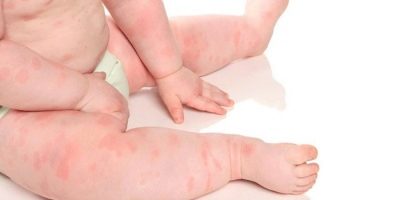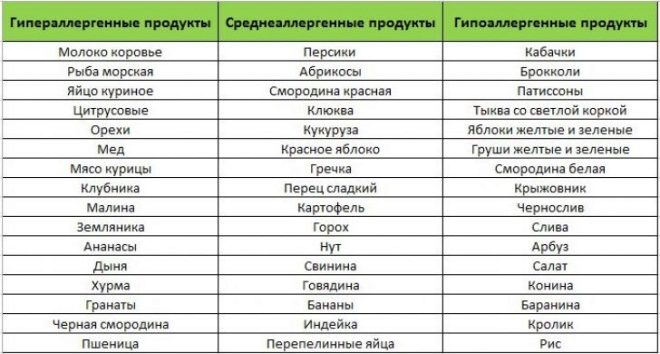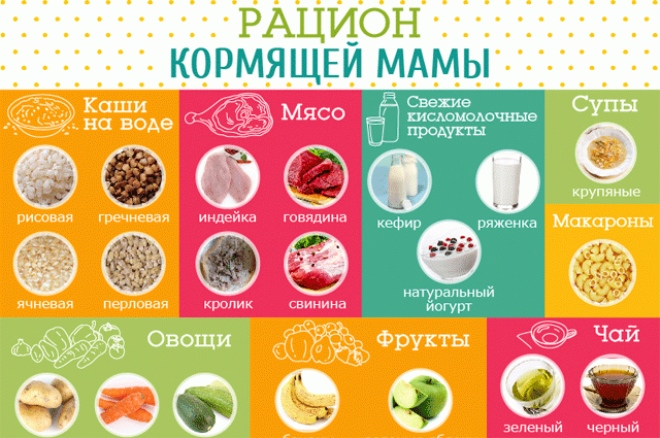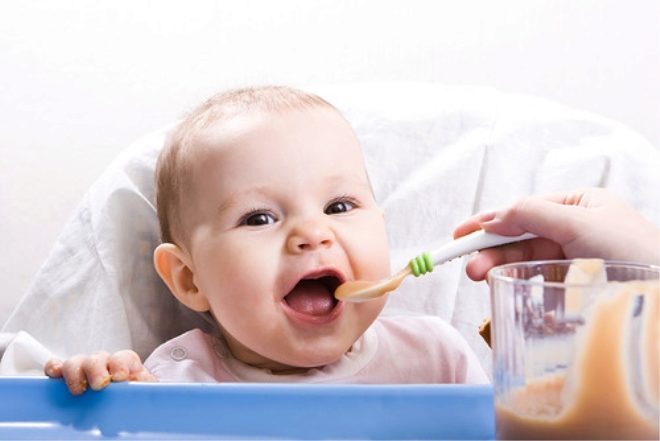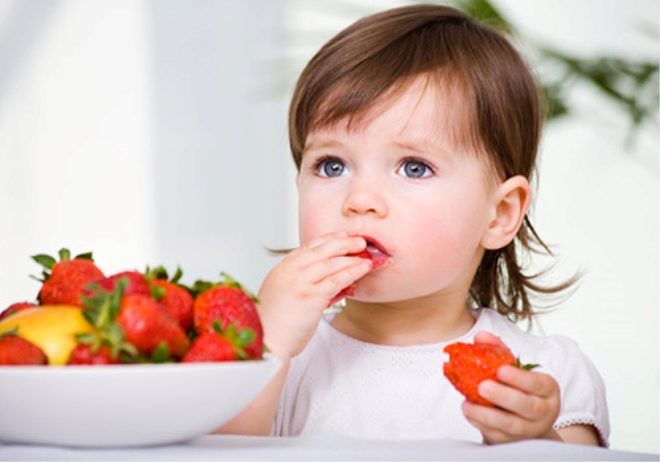Diet for atopic dermatitis in children
Atopic dermatitis is a disease that occurs quite often in children. One of the most common symptoms is the appearance of red itchy spots on the skin. Combing them, the baby can infect the infection and increase inflammation. Treatment of atopic dermatitis is always complex. An important component is a specially designed hypoallergenic diet.
How is the disease?
Atopic dermatitis is a rather severe chronic skin disease. It occurs with periods of exacerbation and remission (well-being period).
Often the onset of the disease occurs in infancy, childhood and preschool age. The exact reason why there is atopic dermatitis, scientists have not found. There are assumptions that genetic hereditary factors, consequences after an infectious disease or allergic manifestations may result in the development of the disease.
Exacerbation of atopic dermatitis can also provoke any other irritants. This may be a contact with a specific allergen. Cause and become substances that enter the body with food.
In the course of the disease after meeting with an allergen in the body, an enormous amount of a specific substance is produced - immunoglobulin E. This reaction is protective and is designed to eliminate the foreign substance that has entered the body. However, this reaction produces many more biologically active substances. They cause symptoms typical of atopic dermatitis:
- The appearance of red itchy spots. Most often they occur in the back of the hands, on the face or on the extensor surface of the forearm.
- There is severe swelling and swelling. The characteristic skin pattern is enhanced, bubbles with liquid contents appear. When localized on the hands and feet when moving, they can cause severe pain.
- In severe cases, well-being deteriorates. The kid becomes moody, refuses to eat. With severe itching, he constantly fidgets in the crib. If the pain syndrome is sufficiently pronounced, the child may cry or even scream.
- If allergy has become systemic. Then, from the nose, dry cough, fever and loss of appetite are also added to the manifestations on the skin. In such cases, the immunologist-allergist should appear to consult and draw up a child's treatment plan.
General recommendations for creating a menu for atopic dermatitis
The most important principle of any diet in atopic dermatitis is to exclude allergen products from the menu. No medication will help to cope with the symptoms of the disease if allergens enter the body regularly.
The main recommendations in drawing up the menu for children prone to dermatitis are the following:
- Diet. It should be frequent, not very large portions. It is better to feed the child every 2.5-3 hours. Such short intervals will allow all the organs of the gastrointestinal tract to function well and to reduce the load on digestion. The last meal is best done an hour before bedtime. The ideal choice - a glass of low-fat kefir, yogurt.
- It is necessary to refuse all products which strongly load the immune system. These include honey, seafood, citrus fruits, bright fruit lozenges with numerous chemical additives, bananas and any other tropical fruits, chips and other snacks with imitation flavors (crab, sour cream and onion, bacon and many others).
- Offer the child to drink plain purified boiled water. Sweet carbonated drinks under the strictest ban! They add a lot of different dyes, which provoke the appearance of new rashes and increase itching.
- All cooked food must be fresh. During the exacerbation period, it is better to prepare food before each meal. Reheating destroys vitamins and does not benefit the child’s body.
- All food is better to cook, simmer or bake in the oven. It is recommended to refuse grilling and roasting. "Light" food is absorbed faster by the body, without causing a feeling of heaviness in the stomach.
- More often have a home. When cooking at home, you know what foods are put on the table. In canteens or cafes, children's food is often prepared in adult professional ovens. In soups or meatballs, there may be spices or foods that are undesirable with a tendency to atopy.
- The diet of the child should also be balanced. For active growth requires a large amount of protein (at least a quarter of the total daily diet). Prefer lean turkey or chicken. Enter the products gradually, watching the reactions of the body.
Drawing up a rotational diet for children
The rotational diet is noticeably inferior in its severity, for example, to an elimination diet. For this reason, it is often given to children with manifestations of atopic dermatitis.
Recommendations for diet with atopic dermatitis will tell Dr. Komarovsky in the video below.
The diet begins with a "start". Usually these are four groups of products: dairy products, meat, various cereals and vegetables of the same type.
Then every four days one new product joins the diet. This diet helps to set up the immune system to work properly, eliminating possible violent reactions to allergens entering the body from food.
The most allergenic and safe products for children with atopic dermatitis
Focusing on scientific research on the effect of products on the possibility of developing allergic reactions and atopic dermatitis, the Union of Pediatricians has compiled tables of products, where they are divided into categories: the most dangerous (highly allergenic), hypoallergenic and neutral.
Highly allergenic products should be completely excluded from the children's menu. They are capable of causing manifestations of atopic dermatitis with the highest probability. Hypoallergenic products can be entered into the diet of the child, but with the obligatory control of the reaction to them. Neutral products can be consumed quietly, without fear that they can provoke a new aggravation.
Highly allergenic products include:
- Berries: Victoria and forest strawberries, red grapes, cherries and cherries.
- Fruits: oranges, lemons, tangerines, grapefruits, apricots, melons, red and yellow apples, fruits from the tropics (except banana), fruit drinks from these fruits, dates, dried apricots and raisins.
- Yellow vegetables: mostly pumpkin. Tomatoes and sauces from them, ketchup. Radish. Root vegetables: beets and carrots. Red and yellow paprika.
- Medium risk products:
- Berries: blackberries, cranberries, cranberries, various types of currants. Watermelon.
- Bananas.
- Legumes Eggplant.
- Neutral Products:
- White berries. Gooseberry.
- Green apples and pears. Plums Sun dried apples or prunes.
- From vegetables: potatoes and cabbage. Leafy greens and green salad. Zucchini, zucchini and squash. Fresh cucumbers and young spinach.
Often, children who are allergic to certain foods may experience allergic reactions to other foods. This is called cross allergy.If a child has an allergy to tree pollen, he also does not tolerate nuts, all shrub fruits, carrots and parsley. These children are not recommended to enter into the diet any kinds of apples, pears, cherries, cherries and many other fruits and berries growing on the trees.
Children who are allergic to chicken eggs almost do not absorb chicken broth, quail eggs, duck and mayonnaise with any inclusion of melange or yolks.
Diet for allergic diathesis in babies from 6 months to 1 year
The appearance of symptoms in infants is often associated with a violation of the mom's diet. Very often, the allergen along with the mother's milk enters the body of the child, causing manifestations of diathesis.
At this time, nursing mommy should include more fermented milk products, lean meat and fish in her menu, and exclude seafood and seaweed for the time being. In the diet should give preference to various types of cereals without gluten and cooked in a sparing mode, meat products. It can steam meatballs or meatballs.
Strictly prohibited:
- all types of smoked sausages and sausages;
- chocolates and tiles;
- citrus;
- spicy dishes and canned food.
With the introduction of complementary foods for babies from 6 months enter the products gradually. If, when a child introduces a new type of product, red spots appear on the body, you should immediately cancel this product and consult a pediatrician for consultation. You may need to conduct additional tests. The baby will take blood for analysis, which will show whether the child has an individual intolerance to a particular product.
When introducing vegetable foods, prefer cauliflower and broccoli. Danish researchers have found that such products are the safest for the first complementary foods. Fruit puree is better to enter from those fruits that grow in your area. For residents of Russia, green apples and pears are considered hypoallergenic. Well tolerated plum.
All porridge should be cooked in water. At first they can be diluted with breast milk. Mixing with cow's milk is undesirable. If a child has lactase deficiency or milk intolerance, after cereal on such a product, he may have diarrheaas well as vomiting.
Be careful and watch for any reaction from the child to the new product. After each introduction to the menu of new food, be sure to check the skin of the child for rashes.
Elimination diet for children
An elimination diet is a kind of experiment, and its goal is not so much to cure as to help identify the food allergen for which the child has symptoms of atopic dermatitis.
The essence of the technique is the gradual withdrawal from the diet of products that can potentially be allergenic, and then gradually introducing them into the diet. This is a provocation of the body, which, with new contact with the allergen, will certainly make this known.
The duration of such an "experiment" should be from 2 to 5 weeks, not more.
At the first stage, glucose and fructose are excluded from the child’s diet. (sugar, honey, fruit, various sauces). This makes it possible to understand if a child has a fungal infection, which caused a tendency to atopy. Fungi are not good without glucose, and the child’s condition begins to noticeably improve.
The second stage includes the exclusion of 1 allergen every two days. Eliminate nuts, wheat, milk, vegetables. The exact list of products for a particular child gives the doctor. The condition of the child usually improves markedly after a dangerous product is eliminated.
Products begin to return to the diet, introducing one every two to three days. Each new eat in sufficient quantities several times a day. A true allergen gives a skin reaction the very same day. The first to return meat products, complete with cereals and fruits,
After identifying 1-2 allergens, the elimination diet should be discontinued.If necessary, later "food provocation" with the permission of the doctor can be repeated.
Important! A child should not starve. Do not hold it on water and bread. Meals should be complete. Prepare for it soups, porridges, mashed potatoes from the products resolved by the doctor. Do not make an elimination diet menu with a provocative test yourself. The doctor must do this.
Watch the following video where an experienced dermatologist talks about the nuances of diet with atopic dermatitis.



